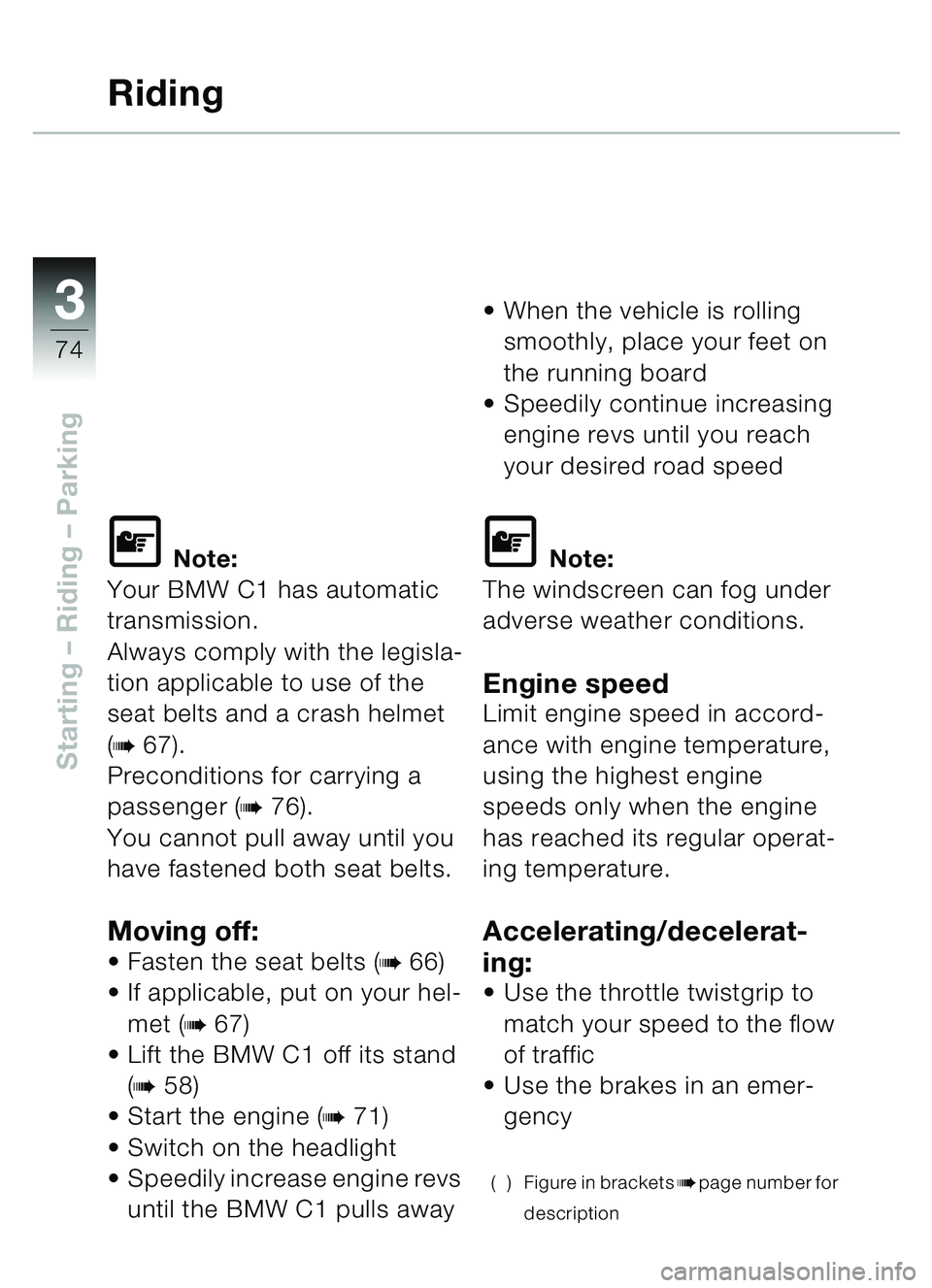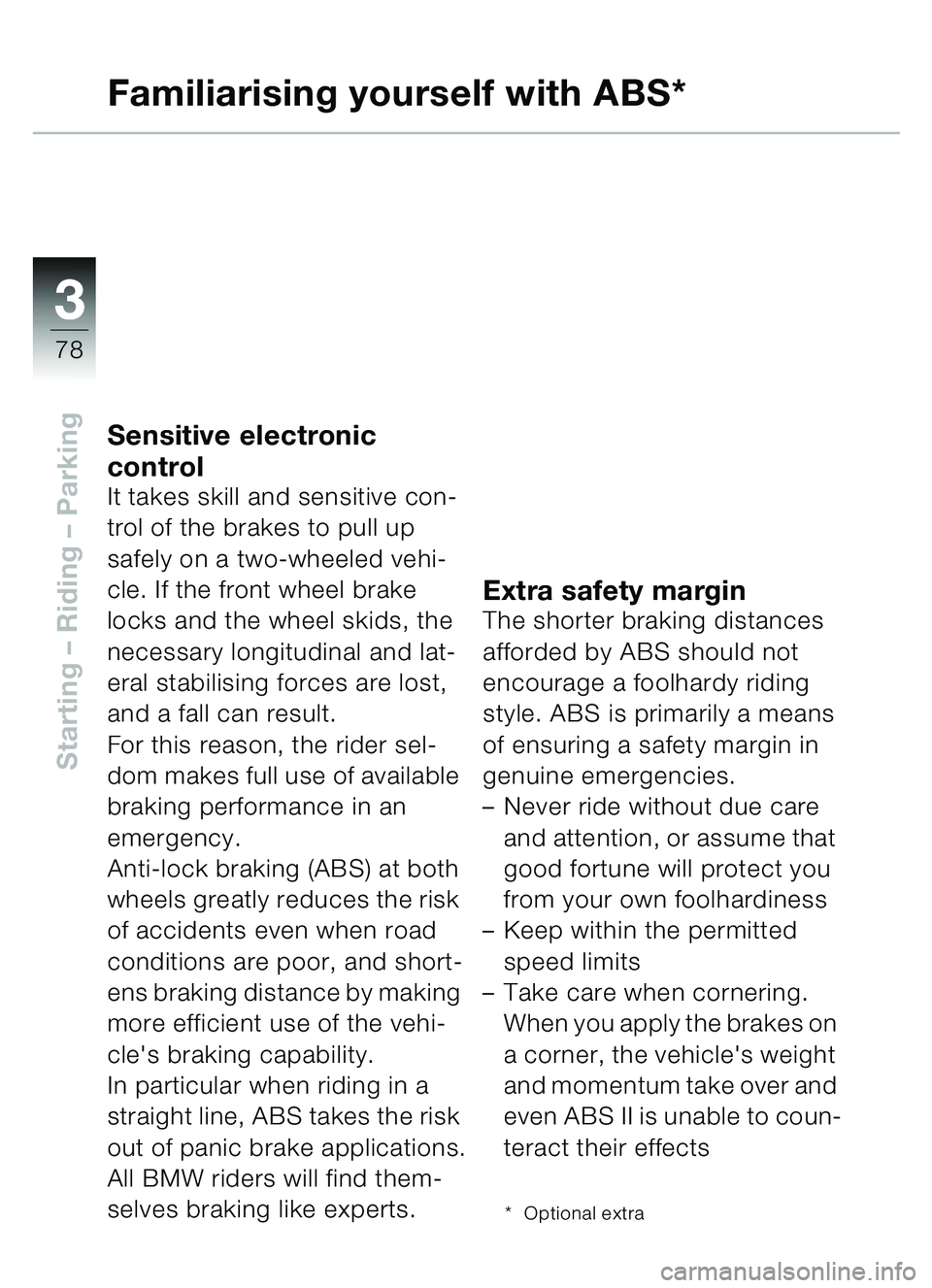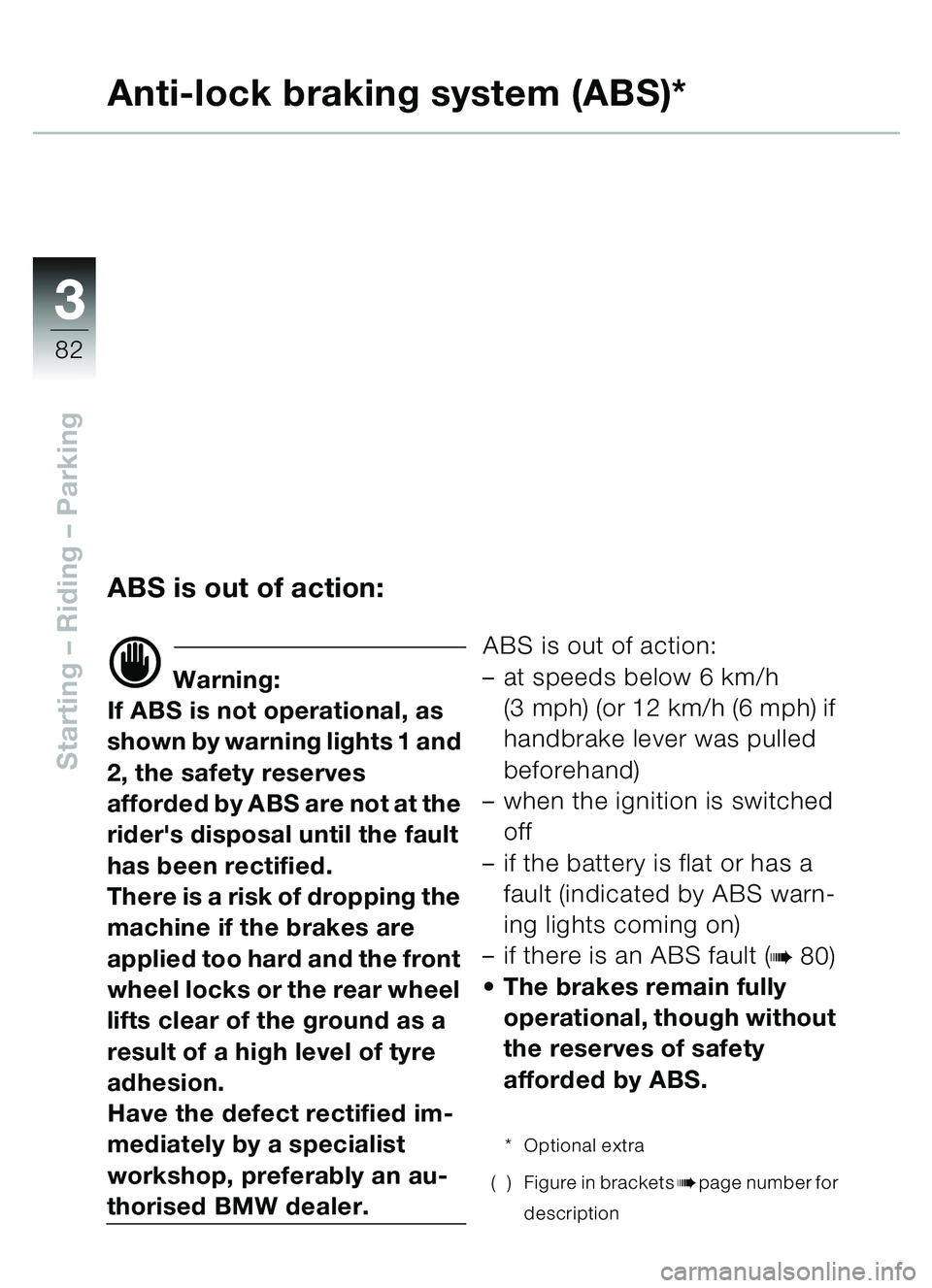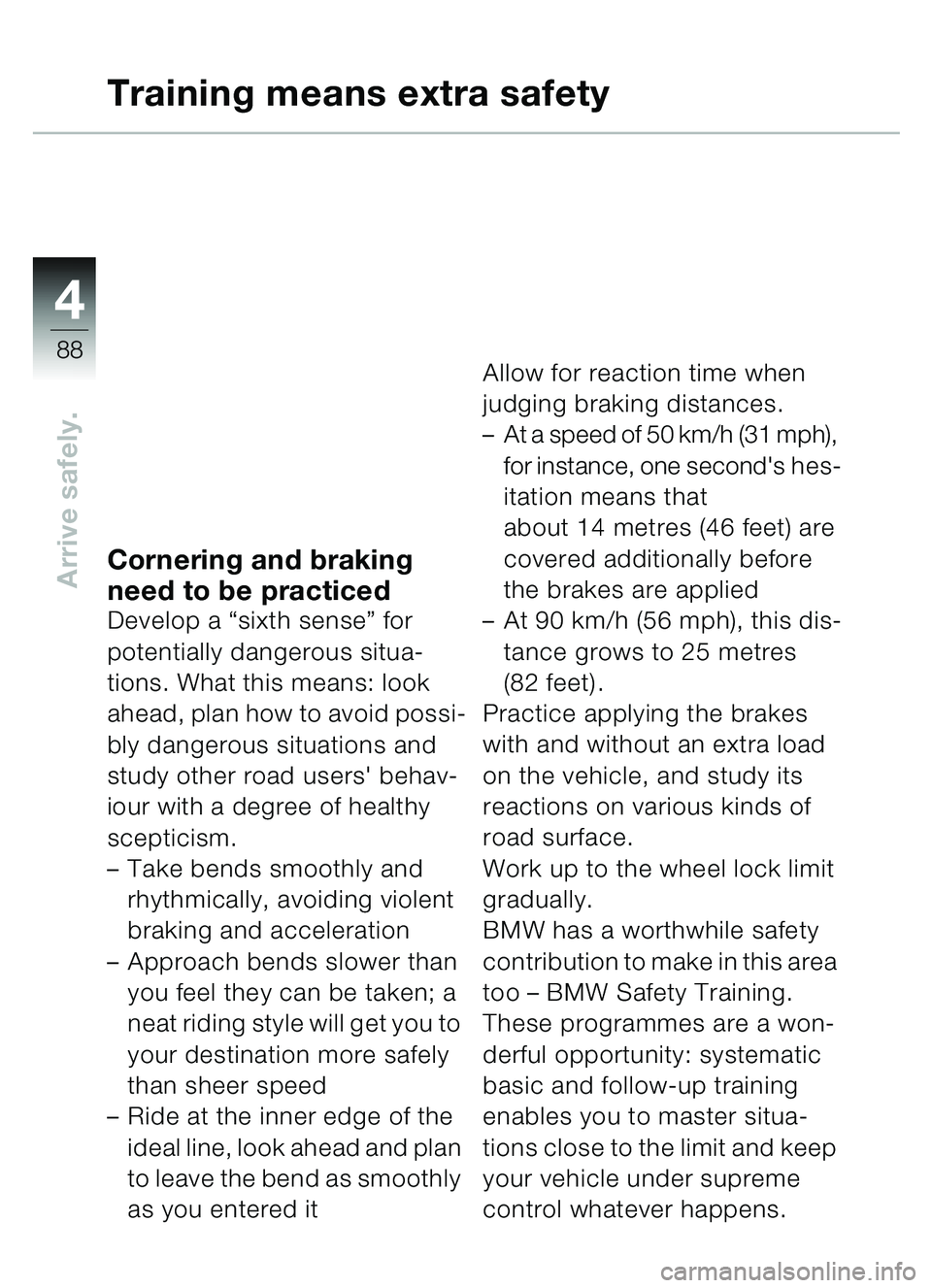Page 76 of 96

33
74
Starting – Riding – Parking
Riding
\f Note:
Your BMW C1 has automatic
transmission.
Always comply with the legisla-
tion applicable to use of the
seat belts and a crash helmet
(
b67).
Preconditions for carrying a
passenger (
b76).
You cannot pull away until you
have fastened both seat belts.
Moving off: Fasten the seat belts (b66)
If applicable, put on your hel-
met (
b67)
Lift the BMW C1 off its stand
(
b58)
Start the engine (
b71)
Switch on the headlight
Speedily increase engine revs
until the BMW C1 pulls away
When the vehicle is rolling
smoothly, place your feet on
the running board
Speedily continue increasing
engine revs until you reach
your desired road speed
\f Note:
The windscreen can fog under
adverse weather conditions.
Engine speedLimit engine speed in accord-
ance with engine temperature,
using the highest engine
speeds only when the engine
has reached its regular operat-
ing temperature.
Accelerating/decelerat-
ing:
Use the throttle twistgrip to
match your speed to the flow
of traffic
Use the brakes in an emer-
gency
( ) Figure in bracketsbpage number for
description
�� �
Page 79 of 96
33
77
Starting – Riding – Parking
Brakes
Wet brakesAfter washing or cleaning your
BMW C1, riding it through water
or in rainy weather, the brake
discs and pads may be wet (or
iced over in winter), so that
there is a delay before the
brakes take effect.
d Warning:
The brakes should always be
applied first to dry them.
Salt on brakesBrake applications may be
delayed if the vehicle was rid-
den on salt-covered roads and
the brakes were not applied for
some time afterwards.
d Warning:
The layer of salt on the brake
discs and pads must first be
worn away by braking.
Oil and grease on brakes
d Warning:
Brake discs and pads must be
free from oil or grease.
Dirt or mud on brakesIf you ride on muddy roads, the
brake discs and pads may
become dirty, so that the brak-
ing effect is delayed.
d Warning:
The brakes must first be
applied until the discs and
pads are clean.
Dirt on the brakes increases
the rate of pad wear.
�� �
Page 80 of 96

33
78
Starting – Riding – Parking
Familiarising yourself with ABS*
Sensitive electronic
control
It takes skill and sensitive con-
trol of the brakes to pull up
safely on a two-wheeled vehi-
cle. If the front wheel brake
locks and the wheel skids, the
necessary longitudinal and lat-
eral stabilising forces are lost,
and a fall can result.
For this reason, the rider sel-
dom makes full use of available
braking performance in an
emergency.
Anti-lock braking (ABS) at both
wheels greatly reduces the risk
of accidents even when road
conditions are poor, and short-
ens braking distance by making
more efficient use of the vehi-
cle's braking capability.
In particular when riding in a
straight line, ABS takes the risk
out of panic brake applications.
All BMW riders will find them-
selves braking like experts.
Extra safety marginThe shorter braking distances
afforded by ABS should not
encourage a foolhardy riding
style. ABS is primarily a means
of ensuring a safety margin in
genuine emergencies.
–Never ride without due care
and attention, or assume that
good fortune will protect you
from your own foolhardiness
– Keep within the permitted
speed limits
– Take care when cornering.
When you apply the brakes on
a corner, the vehicle's weight
and momentum take over and
even ABS II is unable to coun-
teract their effects
*Optional extra
�� �
Page 83 of 96
33
81
Starting – Riding – Parking
Anti-lock braking system (ABS)*
ABS operatingThe ABS is taking effect:
–if pulsating counter-pressure
is felt at the left and/or right
handbrake lever when the
brakes are applied.
\f Note:
Pulsation at the handbrake le-
ver indicates that the ABS is in
action.
The ABS prevents the rear
wheel lifting, depending on rid-
ing style and the applicable
boundary conditions.
* Optional extra
d Warning:
If the handbrake lever can be
moved right to the limit of its
travel, this indicates a
mechanical or hydraulic fault.
Immediately consult a spe-
cialist workshop, preferably
an authorised BMW dealer.
�� �
Page 84 of 96

33
82
Starting – Riding – Parking
Anti-lock braking system (ABS)*
ABS is out of action:
d Warning:
If ABS is not operational, as
shown by warning lights 1 and
2, the safety reserves
afforded by ABS are not at the
rider's disposal until the fault
has been rectified.
There is a risk of dropping the
machine if the brakes are
applied too hard and the front
wheel locks or the rear wheel
lifts clear of the ground as a
result of a high level of tyre
adhesion.
Have the defect rectified im-
mediately by a specialist
workshop, preferably an au-
thorised BMW dealer. ABS is out of action:
–
at speeds below 6 km/h
(3 mph) (or 12 km/h (6 mph) if
handbrake lever was pulled
beforehand)
– when the ignition is switched
off
– if the battery is flat or has a
fault (indicated by ABS warn-
ing lights coming on)
– if there is an ABS fault (
b80)
The brakes remain fully
operational, though without
the reserves of safety
afforded by ABS.
*Optional extra
( ) Figure in brackets
bpage number for
description
�� �
Page 90 of 96

4
88
Arrive safely.
Training means extra safety
Cornering and braking
need to be practiced
Develop a “sixth sense ” for
potentially dangerous situa-
tions. What this means: look
ahead, plan how to avoid possi-
bly dangerous situations and
study other road users' behav-
iour with a degree of healthy
scepticism.
– Take bends smoothly and
rhythmically, avoiding violent
braking and acceleration
– Approach bends slower than
you feel they can be taken; a
neat riding style will get you to
your destination more safely
than sheer speed
– Ride at the inner edge of the
ideal line, look ahead and plan
to leave the bend as smoothly
as you entered it Allow for reaction time when
judging braking distances.
–
At a speed of 50 km/h (31 mph),
for instance, one second's hes-
itation means that
about 14 metres (46 feet) are
covered additionally before
the brakes are applied
– At 90 km/h (56 mph), this dis-
tance grows to 25 metres
(82 feet) .
Practice applying the brakes
with and without an extra load
on the vehicle, and study its
reactions on various kinds of
road surface.
Work up to the wheel lock limit
gradually.
BMW has a worthwhile safety
contribution to make in this area
too – BMW Safety Training.
These programmes are a won-
derful opportunity: systematic
basic and follow-up training
enables you to master situa-
tions close to the limit and keep
your vehicle under supreme
control whatever happens.
�� �
Page 92 of 96
ii
90
Index
AAnti-lock brake system (ABS)Check, 79
Notes, 78
Self-diagnosis, 79
Troubleshooting, 80
BBMW Service, 85
Brake fluidChanging, 35
Checking level, 35-37
Brake pads, checking, 38
Brake pressure, checking, 34
Brakes Handbrake levers, 34
Warnings, 77
CCatalytic converterSafety instructions, 54
Clock Setting, 13
Cockpit Overview, 9
Coolant level
Checking, 29
EEasy-lift mechanism, 55-61
Emergency off (kill) switch for ignition, 19
Engine oil, 30 Filler neck, 7 Engine oil pressure
Warning light, 11, 72
Equipment, 87
FFront brake Brake fluid level, 37
Handbrake lever, 19
Front fairing panel, 6 Installing, 21
Removing, 21
Fuel
Filler cap, 6
Fuse box, 7
GGeneral view Left side, 6
Right side, 7
HHandlebar fittingLeft, 18
Right, 19
Hardtop, 24
Hazard warning flashers, 17
Headlight beam setting RHD/LHD traffic, 40
Headlight beam throw, adjusting, 40
Headlight flasher, button, 18
High/low beam switch, 18
A – H
�� �